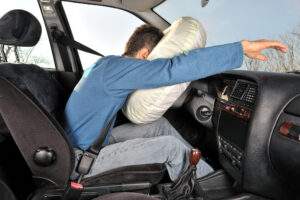Short Drivers and Airbags – What To Know
 The number one safety tip for short drivers and airbags is: keep a safe distance from the steering wheel airbag. The NHTSA recommends the safe distance of 10 inches between the air bag cover on the steering wheel and the chest.
The number one safety tip for short drivers and airbags is: keep a safe distance from the steering wheel airbag. The NHTSA recommends the safe distance of 10 inches between the air bag cover on the steering wheel and the chest.
Why Is There A Concern For Short Drivers And Airbags?
The concern here is that short drivers will sit too close to the steering wheel while driving. The NHTSA states there is a “risk zone” for serious injury if the airbag inflates. The first 2-3 inches in front of the steering wheel the riskiest. It is this zone where the airbags force is the greatest as it bursts through the cover and inflates.
What is this risk? Consider the airbag inflates towards the driver at 200 mph in the first 12-18 inches creating 2000 pounds of force. According to the NHTSA, drivers who are “very close or on top of the air bag when it begins to inflate can be hit with enough force to suffer serious injury of death.”
What Is The Safest Distance From The Steering Wheel?
Again, according to the NHTSA the safest distance to be from the steering wheel is 10 inches from the center of the breastbone to the air bag cover. They explain that the closer to this distance you can get, you lower the risk of airbag injury. Being seated 10 inches form the steering wheel means that the driver will only make contact with the airbag after it has completely inflated.
How Can Short Drivers Distance Themselves From The Airbag?
As a short driver and airbags go, there needs to be a change in the typical driving position. There are ways that you can do this, including:
- 1. Move the seat back as far as possible while still being able to reach the pedals
- 2. Slightly recline the seat back
- 3. Tilt the steering wheel downward.
Pedal Extension For Short Drivers and Airbags
If this does not help, short drivers can improve their safety with pedal extensions. These are devices that can be bolted to the car’s gas and brake pedals. The effect is to bring the pedals closer to the driver, allowing them to sit at a safer distance from the airbag cover in the stering wheel.
What should you do if you are injured in an auto accident or by the airbag?
- 1`. First, if it is a life threatening injury, call 911.
- 2. Take pictures of the vehicle damage and your injuries if there is bruising, cuts or burns.
- 3. Call a doctor, such as Dr. Schmaltz, who has decades of experience treating injury victims. Call 314-731-4383
- —————————–
- (Sources: NHTSA, “Air Bags” page; NHTSA, “Air Bags & On-Off Switches: Information for an Informed Decision”; NHTSA, Traffic Safety Facts, “Occupant Protection in Passenger Vehicles,” published April 2019)
